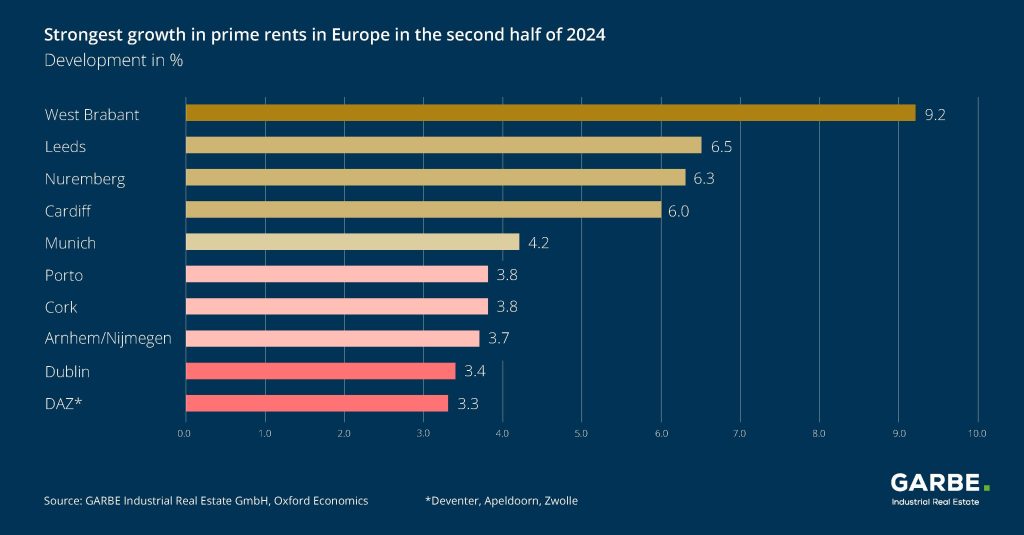GARBE PYRAMID-MAP: Slowing Growth of Prime Rents on European Logistics Real Estate Markets
News 17/02/2025
- Prime rents increased by a mere 0.9 percent during the second half of 2024
- Fastest growth rates found in the United Kingdom and in the Netherlands
- Moderate prime rent growth expected in the years ahead
Hamburg, 17 February 2025. The cycle of soaring rent rates in Europe’s top logistics markets has ended. During the second half of 2024, the average prime rent increased by just 6 cents, rising from 7.30 euros to 7.36 euros per square metre. It is the equivalent of 0.9 percent and thus trails the inflation rate in the eurozone, which was 2.4 percent at the last count. The 2024 take-up in Europe, while representing a modest year-on-year decline (-7 percent), actually exceeds the pre-pandemic figures by a narrow margin. The vacancy rate across Europe was just under six percent.
These are among the findings that GARBE Research presented in its latest GARBE PYRAMID MAP, the 2024 year-end update of the company’s overview of prime rents and prime net initial yields for the 121 most important logistics real estate submarkets in 25 European countries.
Consolidation after the Boom Years
“The slow growth is attributable primarily to the economic situation in Europe. Many companies have stopped expanding for the time being and are consolidating instead. We need to remember that the pandemic saw tremendous demand for logistics facilities. That cycle has now run its course. Also worth noting is the large volume of construction lately. Available supply has recently increased as a result of a time lag between the development and successful letting of new structures. However, the gap is about to close again because building activity has been slowing lately,” elaborated Tobias Kassner, Head of Market Intelligence and Sustainability at GARBE Industrial Real Estate. With respect to the increased vacancy rate, Kassner had this to say: “The current vacancy rate may be higher than it was during the pandemic years, which saw exceptionally low levels between two and three percent. But historically speaking, a rate of around six percent is normal.”
In over half of the logistics regions surveyed, the prime rent level remained stable (57 percent or 69 submarkets), whereas an upward trend was found in roughly one out of three regions (35 percent or 42 submarkets). Only in ten logistics regions did rents actually decline. Established markets like Leeds and West Brabant stand out prominently with increases of 0.60 euros per square metre each, as well as Munich, Nuremberg, Cardiff and London where prime rents rose by 0.50 euros per square metre.

Regional Differences, Some Significant
In Germany, prime rents gained no more than three cents on average. In fact, the average would have remained more or less unchanged had it not been for the growth in Munich and Nuremberg. In six regions—Fulda/Bad Hersfeld, Leipzig, Regensburg, Saarbrücken, Magdeburg and Kassel—prime rents softened slightly.
“With the exception of Leipzig, this involved mainly Class C cities where demand is slow at the moment. In some of these regions, new structures were built on speculation, creating a temporary oversupply,” Kassner added to explain the negative rental growth. “Despite these developments, the German market presents a generally stable picture while consolidating on a high level.”
Prime rents also remained largely stable in Italy, France and the CEE region while going up by 5 cent in Spain. The biggest rent hikes were registered in the United Kingdom (+26 cents) and the Netherlands (+9 cents). Being established markets, these are usually the first to show signs of market movements. “The regionally different developments are attributable to specific market conditions. In Germany, we are seeing a stabilisation after years of dynamic growth, whereas prime rents in the United Kingdom continued to grow, fuelled by higher rates of consumption and robust demand for logistics facilities,” said Kassner.
Forecast by GARBE and Oxford Economics: Robust Rental Growth Expected
The forecast covers the prospective trend in prime rents in 30 European top markets over the next five years. On average, analysts project an annual growth by 2.7 percent or 24 cents, which would narrowly exceed the inflation rate of 2.4 percent. Four cities registered growth of over 3 percent: London, Munich, Manchester and Lyon. Generally speaking, the forecast underlines that the leading markets will continue to see robust growth, albeit without matching the dynamic growth rates of previous years.
For more figures and methodological details, please see the interactive GARBE PYRAMID MAP. The data referenced in our press release are sourced from the PYRAMID project.